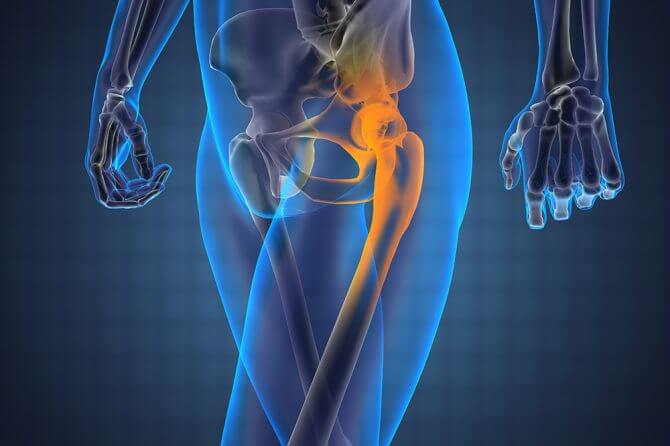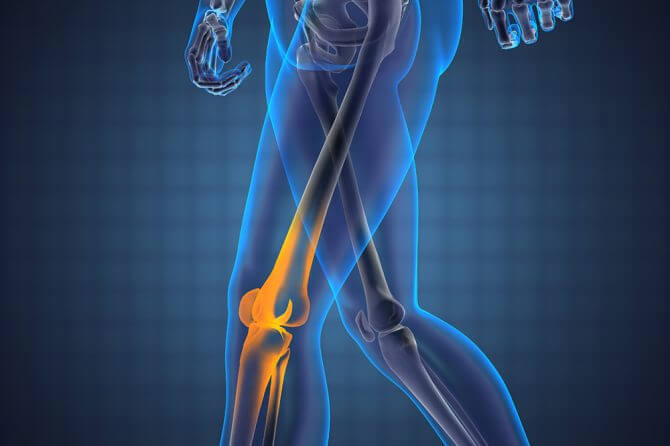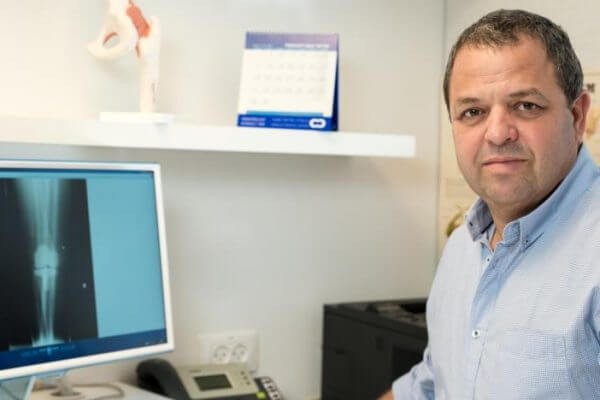Knee and hip joint replacement surgery
Dr. Amit Regev has been performing knee and hip joint replacement surgery since 1993.
Joint replacement surgeries are an effective solution for patients suffering from pain caused by inflammation of the knee or hip joint.
Joint replacement surgery can change the course of the disease and improve all symptoms!
What is Osteoarthritis?
Inflammation of the joints causes pain and swelling in different joints of the body such as knees and hips. There are different types of joint inflammation; but the most common is the degenerative joint inflammation (osteoarthritis), which develops with age.
Osteoarthritis is the result of erosion of the cartilage tissue that covers the surface of the joint. This erosion causes cartilage deformity and results in pain and swelling.
The ability of the cartilage tissue to regenerate or recover is limited. Our body is unable to grow new tissue to replace the damaged cartilage.
The inflammation can also occur among young people, but the chance of developing such a condition increases after age 45.
Osteoarthritis of the knee is the most common among women while men are more likely to develop hip arthritis.
How to treat Osteoarthritis?
The main objective in the treatment of osteoarthritis is to improve mobility (the ability to walk at home and outside) and the quality of life.
In order to achieve this goal, the therapeutic intervention attempts to improve the function of the joint (knee or hip) along with reducing the pain.
There are three methods to treat arthritis:
• Physical therapy: rest to minimize the burden on the joint,
weight reduction or physiotherapy.
• Pain relief with pain medication such as Paracetamol, Advil.
In case of severe inflammation and pain, steroid or hyaluronic acid injections may alleviate the symptoms.
• Joint replacement surgery. The damaged knee or hip joint will be
replaced by artificial joints made of metal and plastic. Surgery is usually recommended for people over the age of fifty who suffer from severe osteoarthritis.
Structure of the hip joint
The hip joint is the junction between the pelvic bone and the femoral head in a place called acetabulum.
The hip joint looks like a mortar and pestle. This shape – together with ligaments and muscles surrounding the joint – maintains its stability.
The bone ends are covered with a soft layer of cartilage that enables the joint to move smoothly and that serves as a shock absorber.
The "lubrication" of the movement is done by synovial fluid, which is released by the synovia tissue inside the joint.
Damage to any of the hip parts, may eventually cause a chain reaction, damage to the other parts, leading to pain in the hip joint and restriction of movement.

Structure of the knee joint
The knee joint is the junction between three bones: the hip bone (Femur), the shin bone (Tibia) and the kneecap (Patella) at the front, covering the joint and serving as a lever to increase the muscle strength that moves the knee. The joint is held together by ligaments and muscles. The bone ends are covered with a soft layer of cartilage that enables the joint to move smoothly and that serves as a shock absorber.
The "lubrication" of the movement is done by synovial fluid, which is released by the synovia tissue inside the joint.Damage to any of the knee parts, may eventually cause damage to the other parts, leading to pain and restriction of movement.

Knee or hip joint replacement surgery
Painful knees or hips and decreased mobility are common as age advances. A restricted capability to walk and move significantly affects the quality of life and reduces the ability to participate in activities we enjoy. Hiking with friends, dancing on your son or daughter's wedding, even your morning entertainment in the neighborhood café are affected when each movement comes with pain.
Various treatments like medication, orthopedic aids, physiotherapy or injections into the joint may help for a certain period with varying levels of success, but may not always be sufficient. Therefore, in recent decades, there is a surgical alternative to these treatments by a total replacement of the damaged joint with an artificial joint.
There are three types of surgery for the treatment of osteoarthritis. Arthroplasty surgery is the main surgery common today with a high success rate as an effective solution to inflammation.
In arthroplasty surgery, the entire joint or one side of it as well as the cartilage are replaced by artificial parts made of metal and plastic. The artificial joints are of high quality and usually there is no need for additional surgery.
The artificial joint
Development of artificial knee and hip joints started in the 1940s. Since then, physicians' abilities and the quality of the implants have been steadily advancing in order to provide a full and long-term solution to joint pain.
The artificial joint is not a part of our body and therefore it does not transmit pain sensation, but it does not accurately reproduce the movement of the knee either. Fortunately, modern implants are designed for motion ranges of 100-120 degrees bending, a range suitable for all necessary functions as well as many recreational activities including sports. The main purpose of artificial joints is to reduce pain.
During surgery
During joint replacement surgery, the ends of the bones and the damaged cartilage around the joint are removed and replaced by a prosthesis. The prosthesis is composed of different parts that replace each separate bone end, thus creating a reconstruction of a healthy joint structure and returning normal activity to the joint.
The artificial joint is made of special metal and polyethylene providing a friction surface.
Many different companies provide a wide range of implants, all similar in their general form, with slight differences in shape or material they are made of.
The prosthesis adjustment is done according to the size of the patient's bone from a series of parts available to the physician during surgery.
Who is eligible for joint replacement surgery?
A patient suffering from joint pains (knee or hip) caused by primary or secondary cartilage damage, who tried conservative treatment without success and is recommended surgical treatment by his orthopedist.
Risk groups
• Patients over age 50
•Patients who have been repeatedly injured due to their occupation which demands exerting continued pressure on the joint, for instance when lifting heavy loads under strenuous activity, or when exercising.
• Patients with rheumatoid arthritis, certain metabolic disorders, iron overload or excess growth hormone.
• Patients with overweight.
When to determine knee or hip joint replacement surgery?
The appropriate time for surgery varies from patient to patient. When the patient feels his quality of life is declining, he has reached the moment to consider surgery.
The patient's age is also of importance. The younger the patient, the less advisable it is to choose surgical treatment.
The general recommendation is around the age of pension when the functional requirements are decreasing and the chance of preserving the implant over time increases (there is no age limit for surgery, the only limit is health).
What are the risks of surgery?
Information about the risks of anesthesia will be given during the initial meeting with the anesthesiologist and depends on the patient's health condition, physical fitness, sensitivities and type of anesthesia.
There is a one percent chance for early infection and venous thrombosis to occur; therefore preliminary treatments to prevent these conditions exist.
At the beginning of the operation, the patient receives a dose of antibiotics to prevent infections, sometimes the treatment will continue until removal of drains from the wound. In addition, from the day of surgery to six weeks after, anticoagulant drugs are given by injection or pills in order to reduce the risk of venous thrombosis.
I decided to have knee or hip joint replacement surgery – what should I do?
You will have a meeting with an orthopedic surgeon who specializes in this kind of operations. You will bring your knee/hip x-rays, as well as all your medical information from your family doctor: a list of diseases, a list of medication and sensitivities.
After a check-up and analysis of the x-rays, the surgeon will set a date for the surgery.
Prior to the surgery, you will undergo a series of blood tests, chest radiography and cardiogram (ECG). Following you will meet with the anesthesiologist who will plan the appropriate anesthesia.
On the day of surgery, you will arrive at the designated time for hospitalization and the nurse will prepare you for surgery. Next you will meet with the surgeon who will mark the location of the surgery on your leg. And then you will be brought to the operating room. The surgery takes about one hour and a half, your stay in the operating room will be about two hours.
The day after the surgery, in the ward, the rehabilitation process begins.
Rehabilitation includes immediate standing on the foot, followed by bending and straightening the joint (knee or hip) with the help and supervision of a physiotherapist. (Most of the patients can manage by themselves in and around their room two days after surgery).
The rehabilitation process may sometimes come with pain, therefor it is important to take medication against pain as prescribed by the surgeon.
Hospitalization takes a few days after which you will return home.
Rehabilitation after knee joint replacement surgery continues at home in the most familiar and comfortable environment.
The process includes physiotherapy, follow-up and recommendations by the attending physician.
The goal is to return within six weeks to three months from surgery to active life and to walk without means of support.
In order to achieve this goal it is recommended to follow the instructions of your doctor and physiotherapist.
Why should you turn to Dr. Amit Regev for the operation?
• Senior surgeon with extensive experience and specialization in joint replacement, either first time or repeat operations.
• Amit Regev has been performing knee and hip joint replacement surgery since 1993.
• Each patient receives the best treatment, professionally and personally.
• Thousands of satisfied patients.
Patients recommend:
"We would like to express our deep gratitude to Dr. Amit Regev, who performed hip replacement surgery on our beloved.
Dr. Regev's warm attitude and wonderful humanity were felt even before surgery, when he visited Ms. Buchnik several times in order to explain and enlighten our knowledge of the subject. These visits and his patience encouraged and uplifted not only the patient's mood, but also that of her worried family before the surgery and after, during hospitalization.
Not less important: Dr. Regev's magic hands; that with their magical touch, skill and professionalism, returned to Ms. Buchnik the quality and enjoyment of life. We do not exaggerate when we say that Dr. Regev was the guarding angel who accompanied us from hospitalization until discharge and who made us turn to a new future."
Pnina B.
"I would like to praise the conduct and behavior of Dr. Regev Amit, Orthopedist, for his warm, cordial, human and professional attitude as he addresses to people with pleasantness and courtesy and with his presence sometimes makes us forget our health sorrows".
Leah A.
"If only there were more doctors like Dr. Regev."
Daniel L.
"Modestly stated: you are a fairytale doctor, more precious than a diamond."
Leah C.
"To Dr. Regev: Thank you for the wonderful attitude I received from you
and for your desire and effort to save my leg
thank you for the smile that contributed to my recovery."
Haya R. and her family
"Thank you for your dedicated and professional treatment
and for the caring. With great respect"
Berta
"Dear Dr. Amit Regev, I want to thank you for the dedicated treatment and the wonderful attitude you gave me. Thanks to you, I can return to full normal functioning. Thank you very much from the bottom of my heart."
Shira A.
"A great man, professional, kind, honest and faithful to the doctor's oath. The warm and cordial attitude gave my mother confidence and made her feel prepared for surgery. A human person who has the patient's best interests in mind and finds a common language at eye level. Accompanies patiently and makes you feel that there is someone to rely on."
Shira Y.
"I want to thank you for your professionalism, immediate attention, the fine attitude, organization and cleanliness."
"I was very afraid of the operation, but you reassured and strengthened me. Today I feel wonderful, thanks to the successful operation and your good and experienced hands. I will wholeheartedly consider operating the other knee as well."
Batya K.
For an appointment, please send an email to: dr.amit.regev@gmail.com





